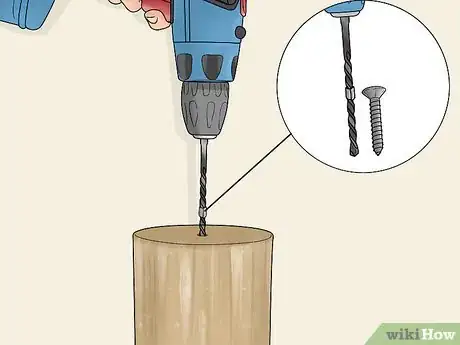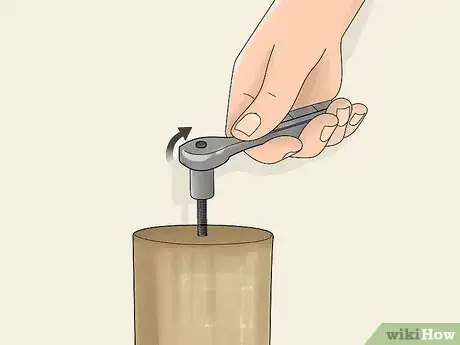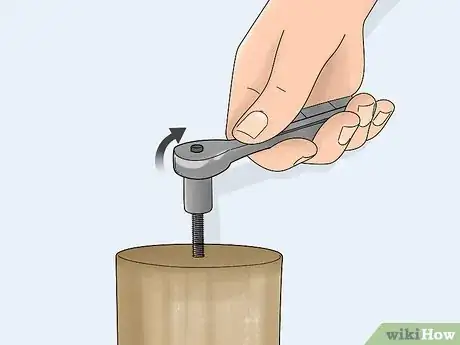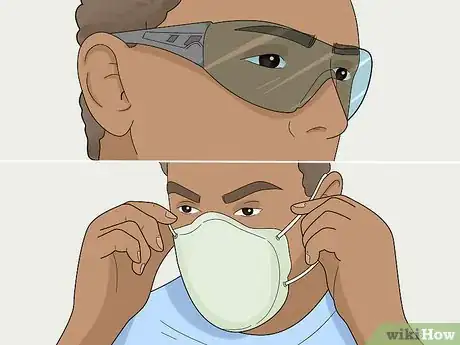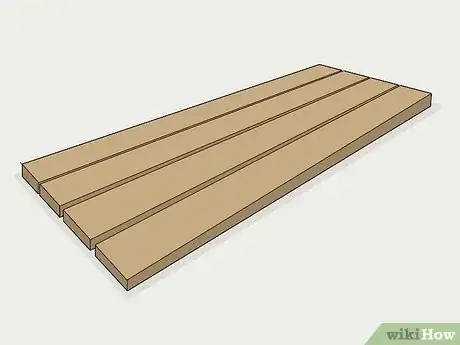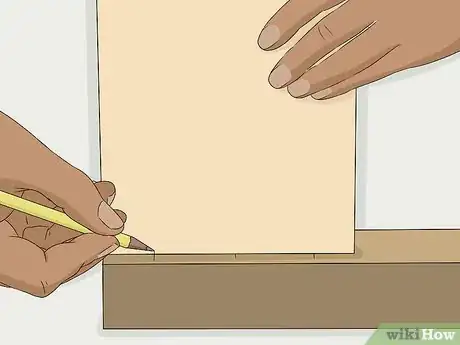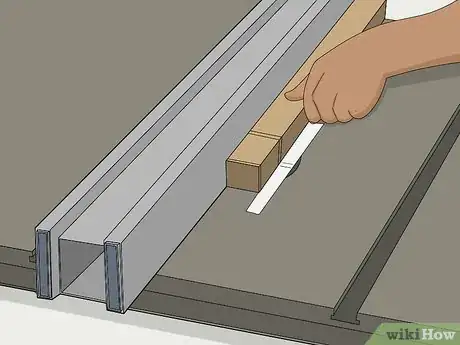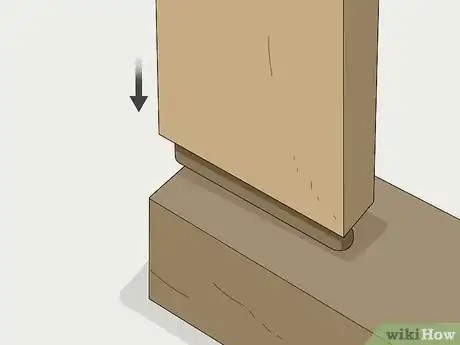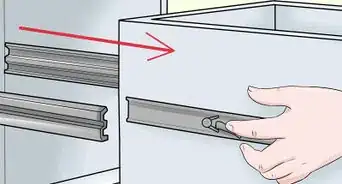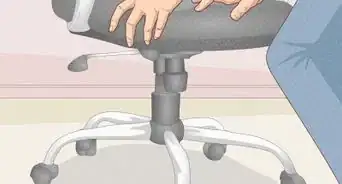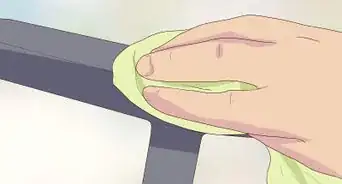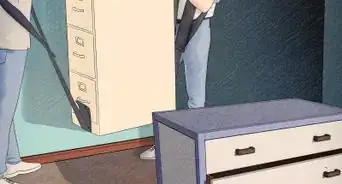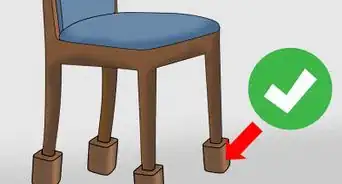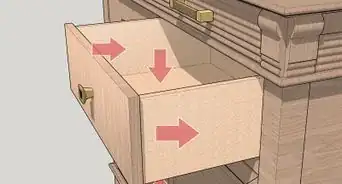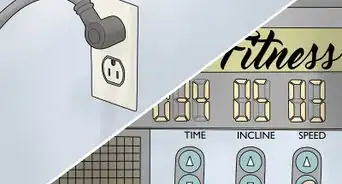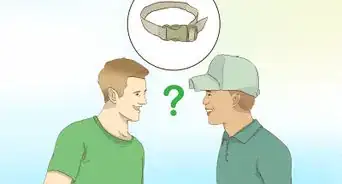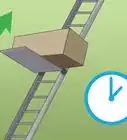This article was co-authored by wikiHow Staff. Our trained team of editors and researchers validate articles for accuracy and comprehensiveness. wikiHow's Content Management Team carefully monitors the work from our editorial staff to ensure that each article is backed by trusted research and meets our high quality standards.
There are 12 references cited in this article, which can be found at the bottom of the page.
This article has been viewed 372,975 times.
Learn more...
You can transform almost any old tabletop by giving it a fresh pair of legs. There are many different mechanisms you can use, but they aren’t as difficult to understand as they first seem. For small tables with thin legs, try using metal plates called surface plates and screw the legs into them. If you’re going to move the table a lot, install small inserts called T-nuts directly into the tabletop and screw the legs into them. Another option for big tables is to make mortise and tenon joints by cutting slots in the wood for parts to plug into.
Steps
Using Surface Plates
-
1Purchase 4 table surface plates and hanger bolts. There are both regular and angled surface plates to choose from. Regular surface plates hold the legs straight vertically while straight surface plates allow you to set them diagonally. You can choose either one and install them the same way. To connect the legs, you will also need a set of matching hanger bolts that are the same size as the central opening in the plates. Hanger bolts are basically screws threaded at both ends to connect to something like a surface plate.
- Shop online or visit a home improvement store to purchase plates and bolts. While shopping, compare the hanger bolts to the surface plates to ensure they are compatible. The size will be listed on the packaging.
- Surface plates are a good choice for small tables without an apron, which is the series of wood panels some tables have on their underside to join the legs to the tabletop. Surface plates work best with thin legs less than 2 1⁄4 in (5.7 cm) in diameter.
-
2Set the surface plates on the corners of the table. Determine where the surface plates will go before securing them in place. They typically go in the corners on the underside of the table, but you can move them to adjust the positioning of the legs. Make sure the plates are equidistant, meaning an equal distance from the table’s edges. If you’re using angled surface plates, turn them so the elevated portions are opposite from the table’s corners, allowing the legs to slant in the right direction.[1]
- If you need a more precise estimate of where to put the plates, measure out from the table edges and mark where each one goes. There is no exact place to put them beside keeping them equidistant, so it depends on where you want them.
- Test the plates by holding the legs up to them. If the legs don’t look like they are positioned correctly, especially with angled plates, then adjust the plates before screwing them in place.
Advertisement -
3Screw the surface plates to the table. Purchased surface plates come with the screws you need to install them. The screws fit the holes, usually 4 of them, around the plate’s outer edge. Before installing the plate, make sure the screws are not long enough to pierce through the entire table. When you’re ready to secure the surface plates, use an electric screwdriver to attach them to the table’s underside.[2]
- If you think the screws might be too long, measure their length and compare it to the table’s thickness. You may need to get shorter screws or try smaller surface plates.
- Screwing the loose plates on can be a little tricky. Clamp them in place or ask someone else to hold onto them so they don’t slide out of position.
-
4Drill a pilot hole through each table leg’s center unless you have pre-installed hanger bolts. Turn the table legs so the top portion, meant to connect to the table, faces you. Then, use a power drill to create the pilot hole down through the center. The pilot holes will prevent the wood from cracking later. To make them, use a drill bit that is roughly the same size as the hanger bolts you plan on using. Also, drill holes that are as deep as the bolts are long.[3]
- Note that you don’t need to do this if you purchase legs with pre-installed hanger bolts. Skip to attaching the legs to the surface plates.
- For example, you might use bolts that are 5⁄16 in (0.79 cm) in diameter. Try using the next lowest drill bit size available, which is usually 19⁄64 in (0.75 cm). Pilot holes work best then they are slightly smaller than the bolts.
- To avoid drilling too far into the wood, wrap a piece of tape around the drill bit. Place it so its distance from the tip is the same length as the bolts. Then, drill down until the tape touches the hole.
-
5Install the hanger bolts through the center of each leg. Set a bolt in each of the pilot holes you made. Start by turning the bolts clockwise by hand until they stay inside the legs. Then, use locking pliers or an open-ended wrench to continue. Keep turning the bolts until they are locked tightly in place.
- To help ensure the bolts fit correctly, you can place a pair of metal nuts on them. Tighten the nuts with a wrench, then insert the bolt’s opposite end into the wood. Use a wrench on the nuts to turn the bolts, then remove them when you’re done.
-
6Connect the hanger bolts to the surface plates. Finishing the installation is as simple as aligning the legs with the hole in the center of each surface plate. Twist the legs clockwise to secure them in place. When you’re done, flip the table up to check that it is sturdy and level.
- Surface plates are great for a quick and easy leg installation. They aren’t complicated, so if the legs don’t seem right, the positioning is likely at fault. Move the legs or the surface plates as needed.
Installing T-Nuts
-
1Purchase 4 T-nuts and hanger bolts. T-nuts are circular connectors that attach to the table’s underside. Each T-nut has a central opening used to secure a table leg. When selecting T-nuts, be sure to compare them to the hanger bolts you plan on using. Get bolts that are the same diameter as the opening on the T-nuts.
- The equipment you need is available online or at most home improvement stores.
- T-nuts are useful for tables you plan on moving a lot. They work well on any type of wood table without an apron but are best for unfinished tables. If you plan on covering the table with another piece of wood or upholstery, T-nuts are a good choice.
- If you are unable to find T-nuts, you can also use threaded inserts. Threaded inserts are similar, circular fasteners that install the same way.
-
2Position the T-nuts near the table’s corners. Flip the table over to figure out where you will secure the T-nuts. The most important part is keeping the T-nuts equidistant, or an identical distance, from the table’s edges. The exact positioning depends on where you want the legs to be. They are often placed close to the corners but can be moved according to your preference.
- If you need more precision when placing the T-nuts, measure out from the edges and mark where each one needs to go.
-
3Drill 4 holes through the base of the tabletop. Create the holes in the spots where you plan on placing the legs. Keep the holes roughly the same size as the openings in the T-nuts. The exact size will depend on the T-nuts you plan on using, so refer to their length and diameter. It will be labeled on the packaging.[4]
- For example, 5⁄16 in (0.79 cm) is a common T-nut diameter. Create same-sized holes with a power drill.
- Be wary of the table’s thickness so you don’t drill all the way through it. Use shorter T-nuts if your table is too thin to support the ones you purchased.
-
4Tap the T-nuts into the holes with a hammer. Place a T-nut into each of the holes you drilled. Position them so the wider, circular end is face up. Gradually tap each T-nut down with a light amount of force until it is level with the wood.[5]
- The opposite end of each T-nut is a central circle with a smaller opening. This side goes into the wood. The base of each T-nut has small blades that will also pass into the wood as you hammer.
-
5Drill a pilot hole through the center of each table leg unless they have pre-installed hanger bolts. Arrange the legs so the top part, meant to connect to the table, faces you. Before drilling pilot holes, refer to the diameter of the hanger screws you purchased. Choose a drill size slightly smaller than that. When you’re ready, drill holes that are the same length as the hanger screws.
- For accuracy, take time to measure out and mark the center point on each leg if you need to.
- To make the pilot holes the correct depth, wrap a piece of tape around the drill bit. Position it so its distance from the tip is the same as the length of the bolts. Drill down into the wood until the tape touches it.
- If you purchased table legs with pre-installed hanger bolts, skip this part. Instead, attach the legs to the T-nuts.
-
6Screw the hanger bolts into the table legs. Fit a bolt into each leg. Turn the bolts by hand to start the installation and, once they stay in place, finish with locking pliers or an open-ended wrench. Make sure the legs feel secure, not wobbly, and won’t come out once you turn the table over.[6]
- Keep the bolts center and straight in the legs. If they are misaligned, the legs will appear crooked when you attach them to the T-nuts.
- To make this part easier, put a pair of metal nots on the end of each hanger screw. Tighten them, slip the screw into the wood, and then use the nuts to tighten the screws. Finish by removing the nuts.
-
7Twist the legs onto the T-nuts until they are even with the table. The hanger bolts fit inside the threaded openings in the center of the T-nuts. Turn them clockwise as far as you can. Make sure the legs fit well against the table. Flip the table over when you’re done to see if the finished product looks level and sturdy.[7]
- Keep twisting the legs until they are even with the table. The hanger bolts fit in the threaded holes in each T-nut, leading to a simple but effective installation that hides the hardware.
Cutting Mortises and Tenons
-
1Put on a dust mask and safety glasses before cutting the table. Protect yourself from the dust and possible wood shards released during the cutting process. If you can, work outdoors to further reduce the amount of dust you have to contend with. Also, avoid wearing a long-sleeved shirt, gloves, or jewelry that could get caught by the saw.
- If you can’t work outdoors, select a well-ventilated spot like a workspace with a strong ventilation fan. Open up nearby doors and windows to direct more of the dust out.
- Keep other people and pets out of the area until you are done and have had a chance to clean up.
-
2Cut boards into rails for the table’s underside if there isn’t an attached apron. These rail boards fit between the table legs, creating an apron. Flip the table over, then rough fit the legs near the table corners. Place the boards between them, measuring the length and size you need them to be. Plan on cutting 4 boards so you have 1 that fits between each leg. Measure the distance between the middle part of each leg to figure out how long the apron rails need to be.[8]
- The exact size the boards need to be will vary depending on where you place the legs. Normally, they are easiest to fashion when the legs are placed right near the table corners, but they don’t have to be put there.
- If your table already has an apron attached, you will see wood panels attached to the underside. Skip this part and screw the legs to the apron rails or remove the rails to cut mortise and tenon joints.
- A mortise and tenon joint is a secure way to connect pieces of wood by making them fit together. A mortise is a slot, which is often cut into table legs. A tenon is a same-sized projection that fits into a mortise.
- The mortise and tenon technique is a classic way to create stable tables. It’s often used for big tables that require plenty of stability, such as picnic or dining room tables. It can also be done for metal.
-
3Mark spots to cut the mortise and tenons in the boards. Plan on cutting mortise slots into the table legs and matching tenons on the apron rails to plug into them. These slots can vary as needed depending on the table you’re working with. For a simple table, you might measure about 5⁄8 in (1.6 cm) from the edge of each leg, and then another 1⁄2 in (1.3 cm) to make a mortise of the same size.[9]
- Remember to fit the leg and apron rails together in order to get an accurate fit. The pieces have to line up so the tenons plug into the mortises once they are cut.
-
4Cut mortises in the table legs with a router. The router is a mobile tool you push along wood to cut smooth, consistent shapes. It’s perfect for cutting a mortise in the center of each leg. After marking the cuts you need to make, lower the router and carefully move around the outlines. Note the thickness of the table legs, taking care not to cut more than ¾ of the way through them.[10]
- Using a router can be dangerous if you’re not careful. Keep a firm grip on it with both hands and keep your fingers up on the safety guards. Move it slowly and shut it off when you’re done.
- One way to make the cutting process easier is to drill holes at the ends of each mortise outline, then follow up with the router. Doing this can make the router glide a little more smoothly over the wood.
- Each leg will have a pair of mortises for the apron rails connecting it to adjacent legs. Make sure the mortise cuts look smooth.
- If you don’t have a router, you could also use a dowel jig to drill holes into each leg and rail. Then, fit wood dowels into the holes. The dowels will allow you to push the pieces together just like with a mortise and tenon design.
-
5Trim tenons on each of the apron rails. Use the router to make matching tenons that fit into the mortise slots. Make one on the end of each rail, centering it according to your outline. The tenon sticks out from the rest of the rail, which rests against the uncut portion of each leg.[11]
- The tenons can be tough to cut to the correct size, so work slowly. Keep them a little bigger if needed, since you can always chip off the excess material later.
-
6Fit the apron rails into the legs to make sure they fit. Position the legs near the corners of the tables, aligning the mortises. Then, plug all of the apron rails into them. When they are cut to the right size, the tenons will join perfectly to the mortises. You won’t be able to see the tenons at all.[12]
- You may need to trim the pieces a little more to get them to fit. If you need to shave them down a little bit, try using a chisel to gradually reduce them.
-
7Use wood glue to secure all of the pieces together. Take apart the mortise and tenon joints, then coat them with a layer of wood glue. Use something strong, such as carpenter’s glue, PVA, or epoxy. If you’re not using wood, make sure you choose something compatible with the type of material you’re using. When you’re done, fit the pieces back together and clamp them in place for about 24 hours to dry.[13]
- Let the pieces dry completely before turning the table back over. Use some effective bar clamps or a similar tool to keep the rails and legs pushed together until the glue solidifies.
- Another option is to screw the rails and legs together. Getting the screws in the right place is tough, so it can easily make your table uneven. To do it, drill the screws diagonally down through the table legs and into the rails.
Expert Q&A
-
QuestionHow do you fix uneven legs on a metal table?
 Jacob PischerJacob Pischer is a Home Improvement Specialist and the Owner of Helpful Badger, a home repair service in Portland, OR. With over four years of experience, Jacob specializes in a variety of handyman services including pressure washing, cleaning gutters, repairing drywall, fixing leaky plumbing fixtures, and repairing broken doors. Jacob studied at Madison Area Technical College and has a background in real estate investment.
Jacob PischerJacob Pischer is a Home Improvement Specialist and the Owner of Helpful Badger, a home repair service in Portland, OR. With over four years of experience, Jacob specializes in a variety of handyman services including pressure washing, cleaning gutters, repairing drywall, fixing leaky plumbing fixtures, and repairing broken doors. Jacob studied at Madison Area Technical College and has a background in real estate investment.
Home Improvement Specialist Metal tables appear wobbly when one of the legs is bent. Start by figuring out which leg that is; then, use a vise to bend the table leg back to its correct shape. Just be sure to sandwich the table leg between thin pieces of wood as you secure it in the vise--otherwise, you'll damage the metal.
Metal tables appear wobbly when one of the legs is bent. Start by figuring out which leg that is; then, use a vise to bend the table leg back to its correct shape. Just be sure to sandwich the table leg between thin pieces of wood as you secure it in the vise--otherwise, you'll damage the metal. -
QuestionHow do you stabilize a wobbly wood table?
 Jacob PischerJacob Pischer is a Home Improvement Specialist and the Owner of Helpful Badger, a home repair service in Portland, OR. With over four years of experience, Jacob specializes in a variety of handyman services including pressure washing, cleaning gutters, repairing drywall, fixing leaky plumbing fixtures, and repairing broken doors. Jacob studied at Madison Area Technical College and has a background in real estate investment.
Jacob PischerJacob Pischer is a Home Improvement Specialist and the Owner of Helpful Badger, a home repair service in Portland, OR. With over four years of experience, Jacob specializes in a variety of handyman services including pressure washing, cleaning gutters, repairing drywall, fixing leaky plumbing fixtures, and repairing broken doors. Jacob studied at Madison Area Technical College and has a background in real estate investment.
Home Improvement Specialist Many wooden table lags have a cloth pad on the bottom, which prevents your floors from getting scuffed up. Wooden tables often get wobbly when one of these pads come off, so your best bet is just adding a new sticky pad.
Many wooden table lags have a cloth pad on the bottom, which prevents your floors from getting scuffed up. Wooden tables often get wobbly when one of these pads come off, so your best bet is just adding a new sticky pad. -
QuestionWhat is the ideal space for attaching four legs to a 36-inch round top?
 Community AnswerUsually, when designing a round table, you make a square skirt to accommodate the legs. The square is like a box that is attached to the circle. A leg will be located at each corner of the square. The leg will have a square end that fits into the corner. If you just want to attach the legs to the table, you can use a table plate -- it attaches to the bottom of the table and has threads for a screw that is screwed into the leg.
Community AnswerUsually, when designing a round table, you make a square skirt to accommodate the legs. The square is like a box that is attached to the circle. A leg will be located at each corner of the square. The leg will have a square end that fits into the corner. If you just want to attach the legs to the table, you can use a table plate -- it attaches to the bottom of the table and has threads for a screw that is screwed into the leg.
Warnings
- Operating power tools is dangerous, so wear a dust mask and safety glasses when cutting wood. Work in a ventilated space and keep other people away until you’re done.⧼thumbs_response⧽
Things You'll Need
Using Surface Plates
- Ruler
- Pencil
- Power drill
- Drill bit
- Surface plates
- Hanger bolts
Installing T-Nuts
- Ruler
- Pencil
- Power drill
- Drill bit
- T-nuts
- Hanger bolts
Cutting Mortises and Tenons
- Ruler
- Pencil
- Wood router
- Dust mask
- Safety glasses
- Wood glue
References
- ↑ https://www.youtube.com/watch?v=55zja3o_JdY&t=48
- ↑ https://www.youtube.com/watch?v=n7Gl7ybWbiM&t=172
- ↑ https://www.youtube.com/watch?v=Cr0LkRh3m1I&t=28
- ↑ https://www.youtube.com/watch?v=FjMrAUB49EU&t=77
- ↑ https://www.youtube.com/watch?v=FjMrAUB49EU&t=124
- ↑ https://www.youtube.com/watch?v=iSSh1qfHxMs&t=61
- ↑ https://www.youtube.com/watch?v=iBIM303lrug&t=20
- ↑ https://www.youtube.com/watch?v=BU8eVyqTVEs&t=140
- ↑ https://www.youtube.com/watch?v=OMwNRUnNChg&t=53
About This Article
To attach table legs with surface plates, start by picking ones with pre-installed hanger bolts, if possible, since this will save you a step. If not, buy a package of hanger bolts for larger tables or dowel screws for smaller tables. Install your hanger bolts inside your table legs by drilling a pilot hole that goes into the center of the leg and then screw a bolt tightly into the top of each leg. Align the square surface plates against the corners and screw the top part of the hanger bolt into the plate. To learn how to attach legs to a table using T-nuts, keep reading!



